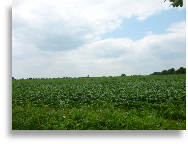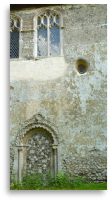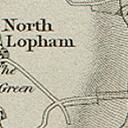

Please note:
The information published on this site is believed to be correct but carries no guarantee of accuracy
The products and services described are not endorsed by the site editor: details and listings are for information only
History
Early History
 The Norfolk Heritage Explorer http://www.heritage.norfolk.gov.uk/record-
The Norfolk Heritage Explorer http://www.heritage.norfolk.gov.uk/record-details?TNF962 provides a useful Parish Summary. This lists two Neolithic finds, a greater number of Bronze age finds including an axe head and spear head and more numerous Saxon artefacts. North Lopham is relatively close to Grimes Graves, which is an extensive 96 acre Neolithic flint mining complex, situated approximately 15 miles to the northwest.
One of the reasons for the location of the Lophams is the position of Lopham Ford, the narrow raised ‘bridge’ of land that offered the only safe crossing point across the fens where the Waveney and the Little Ouse rise. Lopham Ford now sits on the Norfolk / Suffolk border to the south of South Lopham , north of Redgrave. Serpell suggests this crossing as a potential derivation of the name Lop(pe)-ham, based on the Old Norse word ‘lope’ - stride, which could have referred to a crossing. Other suggestions for the derivation include reference to the name of Loppa, a potential early inhabitant; ‘lop’ as in ‘to cut’ - referring to the clearing of forested areas or a rather more charming association with the Great Raft spider, whose preserved habitat is in the Lopham & Redgrave Fen, as the Anglo Saxon for spider was ‘lobbe’ which became ‘loppe’ in early English.
The Heritage Gateway provides the official listing of archaeological and built evidence. Some of the most notable finds include that of a Roman Villa in a field to the north of Lodge Farm. The initial excavations are noted as being carried out in 1951 and two subsequent dates for finds are also given. The site has been ploughed into, but evidence of a villa and associated buildings was identified. Roman coins have been found in several other locations including at the south end of the village and to the west of The Street. There was certainly some Anglo-Saxon settlement at the Lophams, the freemen noted in Domesday are from the reign of Edward II (1042 - 1066) and are named as Ofl and Alsi.
William the Conqueror is said to have united North and South Lopham under the name Lopham Magna prior to gifting the manor to Roger Bygot (Bigot / Bigod), for services rendered as a comrade-in-arms. He was made Sherriff of Norfolk and Suffolk, having substantial land holdings in both counties. Although no buildings remain in North Lopham from this period, the magnificent Norman Tower of St Andrews, South Lopham and the earlier Saxon window testify to the Lophams as being a place of settlement and worship for nearly a thousand years. Bygot (Bigod) was to found the Cluniac Priory of Saint Mary in Thetford, where he was buried in 1107. The building work was completed by his son William (1114) who was the patron for the great Norman tower at St Andrews (then St Nicholas), South Lopham which is attributed to 1120. The Church had been gifted to the Priory and retained an association with it for many centuries.
Lopham appears in the initial Little Domesday Book of 1086 as ‘Lopham Alia’, recording ‘Roger Bigot and 10 beehives.’ Kenninghall to the north is noted as ‘Kings Land in the custody of Godric. Three mills and 324 pigs’. Although it is clear that there would have been a church at South Lopham in 1086, it is not recorded. This could have been because it was not included as part of the ‘value’ of the manor. However, churches were often omitted from the records. Rectors of Lopham are recorded from 1332
The Lophams continue to be noted throughout the Exchequer Rolls of the 14th, 15th & 16th centuries, being part of the Guiltcross Hundred. By the 17th century North and South Lopham are separately listed in records such as the ‘Hearth Roll of 1673’. The Lophams continued their association with the Earls of Norfolk who retained a park and hall to the north at Kenninghall Place.
The structures which remain from the medieval period, such as Trennel House and Church House confirm that North Lopham has been a place of continual settlement. The properties have been extended and modified, new materials and styles have been grafted into and onto existing fabric. In other buildings external brickwork hides much older timber frame constructions – simple cottages have been extended, faced and re-roofed to reflect the needs and aspirations of inhabitants.
St Nicholas Church North Lopham may have been built on the site of an earlier structure and elements of the existing structure have been attributed to the 14th century. However, the earliest records date from the 15th century, prior to the construction of the tower which commenced in 1479. A useful record of Lopham history can be found in Francis Blomefield’s ‘An Essay towards a Topographical History of the County of Norfolk’, 1736. Blomefield was the Rector of Fersfield, a neighbouring village and he would therefore have had a personal knowledge of the Lophams. Blomefield states that in 1736 there were ‘74 dwelling houses, 92 families and 470 inhabitants of North Lopham’ . It is interesting to note that Blomefield describes St Nicholas Church (then St Andrew the Apostle) as having a thatched nave, a leaded south aisle and a tiled south porch.
For anyone looking for detailed information on the inhabitants of the Lophams, the Parish records are invaluable. They offer not only a record of the size of the population but also an insight into the relationships and occupations of Lopham people.
 The Norfolk Heritage Explorer http://www.heritage.norfolk.gov.uk/record-
The Norfolk Heritage Explorer http://www.heritage.norfolk.gov.uk/record-One of the reasons for the location of the Lophams is the position of Lopham Ford, the narrow raised ‘bridge’ of land that offered the only safe crossing point across the fens where the Waveney and the Little Ouse rise. Lopham Ford now sits on the Norfolk / Suffolk border to the south of South Lopham , north of Redgrave. Serpell suggests this crossing as a potential derivation of the name Lop(pe)-
The Heritage Gateway provides the official listing of archaeological and built evidence. Some of the most notable finds include that of a Roman Villa in a field to the north of Lodge Farm. The initial excavations are noted as being carried out in 1951 and two subsequent dates for finds are also given. The site has been ploughed into, but evidence of a villa and associated buildings was identified. Roman coins have been found in several other locations including at the south end of the village and to the west of The Street. There was certainly some Anglo-
William the Conqueror is said to have united North and South Lopham under the name Lopham Magna prior to gifting the manor to Roger Bygot (Bigot / Bigod), for services rendered as a comrade-

Lopham appears in the initial Little Domesday Book of 1086 as ‘Lopham Alia’, recording ‘Roger Bigot and 10 beehives.’ Kenninghall to the north is noted as ‘Kings Land in the custody of Godric. Three mills and 324 pigs’. Although it is clear that there would have been a church at South Lopham in 1086, it is not recorded. This could have been because it was not included as part of the ‘value’ of the manor. However, churches were often omitted from the records. Rectors of Lopham are recorded from 1332
The Lophams continue to be noted throughout the Exchequer Rolls of the 14th, 15th & 16th centuries, being part of the Guiltcross Hundred. By the 17th century North and South Lopham are separately listed in records such as the ‘Hearth Roll of 1673’. The Lophams continued their association with the Earls of Norfolk who retained a park and hall to the north at Kenninghall Place.
The structures which remain from the medieval period, such as Trennel House and Church House confirm that North Lopham has been a place of continual settlement. The properties have been extended and modified, new materials and styles have been grafted into and onto existing fabric. In other buildings external brickwork hides much older timber frame constructions – simple cottages have been extended, faced and re-
St Nicholas Church North Lopham may have been built on the site of an earlier structure and elements of the existing structure have been attributed to the 14th century. However, the earliest records date from the 15th century, prior to the construction of the tower which commenced in 1479. A useful record of Lopham history can be found in Francis Blomefield’s ‘An Essay towards a Topographical History of the County of Norfolk’, 1736. Blomefield was the Rector of Fersfield, a neighbouring village and he would therefore have had a personal knowledge of the Lophams. Blomefield states that in 1736 there were ‘74 dwelling houses, 92 families and 470 inhabitants of North Lopham’ . It is interesting to note that Blomefield describes St Nicholas Church (then St Andrew the Apostle) as having a thatched nave, a leaded south aisle and a tiled south porch.
For anyone looking for detailed information on the inhabitants of the Lophams, the Parish records are invaluable. They offer not only a record of the size of the population but also an insight into the relationships and occupations of Lopham people.
References:
Serpell, Michael Friend (1980) 'A History of the Lophams', Phillimore & Co Ltd, London (ISBN 0 85033 371 7)
Blomefield, Francis, (1739) ‘An Essay towards a Topographical History of the County of Norfolk’, available online Google books
Norfolk Heritage Explorer : http://www.heritage.norfolk.gov.uk/home last accessed 01/01/2014
